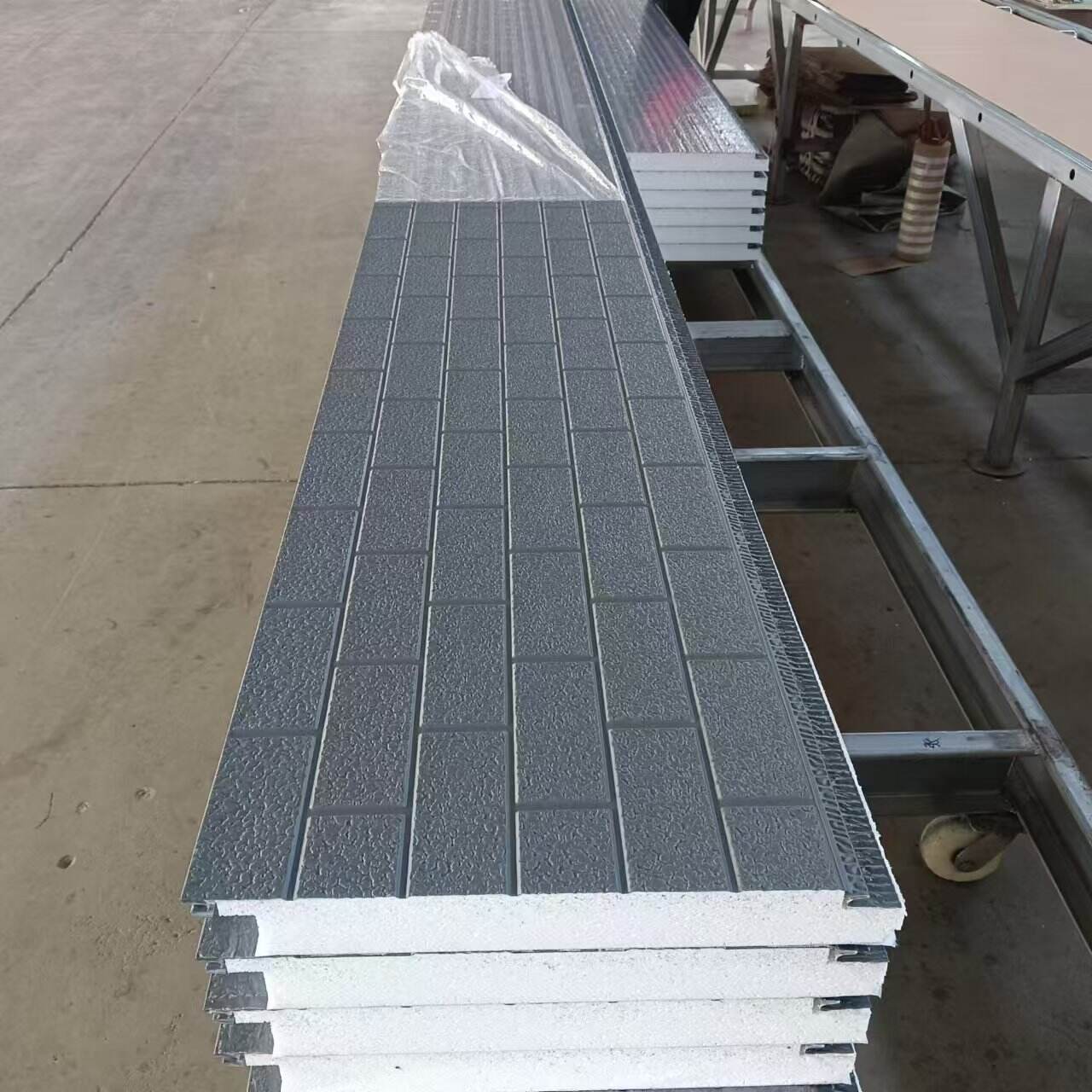Structural Composition of Sandwich Panels
Layered Design: Metal Skins & Lightweight Core
The ingenious design of sandwich panels comprises a dual-layer structure that balances strength with efficiency. The outer layers, typically made of metals such as aluminum or galvanized steel, provide significant durability and resilience. These metals are chosen for their ability to withstand weathering and mechanical wear. The metal skins of sandwich panels not only confer tensile strength but also offer corrosion resistance, ensuring the longevity of the panels under various environmental conditions.
The central core plays an equally vital role in this layered design. By incorporating a lightweight yet robust core, sandwich panels offer superior thermal insulation and structural integrity, which are crucial for energy conservation and stability. This arrangement minimizes material waste while maintaining high performance. Metals like aluminum and steel demonstrate impressive tensile strength-to-weight ratios, further enhancing the panel's efficiency. By adopting such efficient materials, sandwich panels offer a blend of physical and functional performance that is unmatched by traditional building methods.
Core Material Options: EPS, PIR, Rockwool & Beyond
Sandwich panels showcase versatility through the diverse core materials used in their construction, each suited to specific applications. Expanded Polystyrene (EPS) is a popular choice for those seeking cost-effective solutions since it provides adequate insulation at a reasonable price point. Its lightweight nature also aids in easy handling and installation, making it an asset in construction projects requiring speed and efficiency.
Polyisocyanurate (PIR), on the other hand, offers enhanced thermal resistance, making it ideal for energy-efficient applications where temperature control is paramount. Its higher thermal resistance compared to EPS translates into better energy savings. Additionally, Rockwool is renowned for its excellent fire-resistant qualities, making it indispensable in industries where fire safety is a priority. It provides not only thermal insulation but also soundproofing benefits, backed by robust fire testing statistics. These varied core options showcase the adaptability of sandwich panels to meet different construction needs.
Load-Bearing Capacity vs. Foundation Requirements
Understanding the load-bearing capacities of sandwich panels is critical when considering construction methods. These panels are designed to support various loads with minimal foundational requirements, often simplifying the construction process. Common usages highlight their ability to bear significant vertical loads, making them suitable for both wall and roof applications without excessive sub-structural support.
In building designs, considerations of load capacities influence the choice of panels. For example, a high load-bearing capacity is crucial for panels used in roofing applications where they must support both their weight and additional loads like snow or equipment. Vertical loads place different demands on sandwich panels compared to horizontal loads, especially in structures requiring expansive, open spaces without internal supports. By adhering to construction standards, designers can make informed decisions, optimizing material use without compromising safety or functionality.
Incorporating these panels can streamline construction projects by reducing the need for extensive foundations, leading to faster and more cost-effective builds. The intrinsic balance of strength and minimal weight in sandwich panels offers construction flexibility with reliable performance across various applications.

Key Benefits Driving Adoption
Energy Efficiency Through High R-Value Insulation
Energy efficiency is a pivotal factor driving the adoption of sandwich panels, underscored by their high R-Value insulation. R-Value is a measure of thermal resistance, crucial in determining a building's energy efficiency. Higher R-Values signify superior insulation capabilities, which are essential in minimizing heat transfer. By implementing sandwich panels with high R-Values, buildings can enjoy significant energy savings. Studies have demonstrated that structures utilizing these panels show reduced heating and cooling costs, resulting in substantial financial savings over time. For instance, buildings with intense climate control requirements can see noticeable reductions in energy consumption, enhancing their environmental and economic performance.
Fire Resistance & Acoustic Performance
Sandwich panels offer significant fire resistance and acoustic performance benefits. Various core materials, such as EPS, PIR, and Rockwool, provide differing levels of fire safety—PIR and Rockwool leading with superior ratings. These materials help prevent the spread of fire, buying critical time during emergencies. Meanwhile, their dense insulating layers contribute to excellent soundproofing, achieving significant decibel reduction. For example, case studies in schools and hospitals have highlighted the critical role these panels play in creating safer and quieter environments. The combination of fire resistance and acoustic enhancement makes them a preferred choice for structures where safety and noise control are paramount.
Durability in Extreme Weather Conditions
Sandwich panels are recognized for their durability in extreme weather conditions, effectively maintaining structural integrity under various environmental stresses, such as strong winds and heavy snow loads. Their design not only supports robust wind resistance but also offers effective insulation, even in harsh climates. Supported by environmental testing, sandwich panels have been shown to withstand challenging conditions, ensuring longevity and reduced maintenance costs. Coating options further enhance their lifespan, providing protection from corrosion and UV damage. This resilience makes them an ideal choice for constructions in areas prone to severe weather, safeguarding investments in infrastructure.
Aesthetic Flexibility for Modern Architecture
The aesthetic flexibility of sandwich panels is a boon for modern architecture, allowing for creative customization in colors and textures to suit diverse architectural styles. These panels can be designed to complement or contrast with existing structures, offering a seamless integration of modern aesthetics. Innovative projects worldwide have embraced sandwich panels for their visual appeal, showcasing trends toward sleek and minimalist architectural solutions. Insights from architects emphasize the balance of functionality and aesthetics, as sandwich panels meet structural demands while allowing for expressive design elements. This dual benefit broadens their appeal across various architectural applications.
Industrial & Commercial Applications
Cold Storage & Refrigerated Warehousing Solutions
In the realm of cold storage, sandwich panels play a pivotal role due to their exceptional thermal insulation properties. This quality is essential for maintaining low interior temperatures, vital for food preservation and pharmaceuticals. These panels help in significantly reducing energy consumption compared to traditional methods. Statistics from energy management studies show up to a 30% reduction in energy usage for warehouses utilizing advanced sandwich panel technology. Moreover, choosing suitable panels is crucial to comply with stringent food safety standards, further driving their adoption in refrigerated warehousing.
Rapid Construction of Prefab Facilities
Sandwich panels are revolutionizing the construction of prefab facilities by streamlining the build process. Their modular nature dramatically cuts down construction timelines—studies indicate a 50% reduction when compared to traditional building methods. Businesses can significantly minimize downtime, as evidenced by case studies where facility completion times were halved using sandwich panels. Construction professionals frequently highlight the advantages of these panels, praising their speed and efficiency in quick build projects, without compromising on quality or durability.
Clean Room Enclosures for Sensitive Environments
Sandwich panels are indispensable in creating clean room enclosures essential for industries such as pharmaceuticals and biotechnology. They offer airtight construction, necessary for controlling temperature, humidity, and contamination. Industry guidelines emphasize their utility in maintaining strictly defined environmental conditions. Evidence from operations showcases notable efficiency improvements; for instance, manufacturing units have reported enhanced production stability after incorporating panel solutions, underscoring their significance in sensitive environments.
Retail Spaces & Office Complexes
The versatility of sandwich panels makes them particularly appealing for retail spaces and office complexes. Their design flexibility allows for customization that meets both aesthetic and functional needs, making them a cost-effective choice. Case studies of notable retail projects illustrate that sandwich panels successfully balance visual appeal with practicality. Trends in commercial architecture increasingly favor these panels due to their adaptability, enabling efficient space usage while enhancing structural and aesthetic elements of the building.
Material Selection Strategies
Matching Core Types to Project Specifications
Choosing the right core material for sandwich panels is crucial to meet specific project specifications and requirements. Every project environment mandates different load tolerances and environmental considerations, necessitating precise core choices. Key strategies for matching these cores include analyzing environmental conditions, intended load requirements, and performance goals. For example, in areas exposed to high humidity or extreme temperatures, a core material with superior thermal insulation and moisture resistance would be ideal. Industry standards, such as ASTM C177 for thermal properties and ASTM D1621 for compressive strength, guide these selections and ensure the core material effectively aligns with the end-use applications, be it load-bearing panels or thermal barriers.
Moisture Resistance for Food Processing Plants
Moisture-resistant sandwich panels are essential in food processing facilities to prevent contamination and ensure product safety. These panels need robust moisture barriers to combat humid conditions and frequent washdowns typical of food environments. Popular materials engineered for moisture resistance include polyurethane and polyisocyanurate, offering both durability and hygienic advantages. Studies show that these materials effectively inhibit microbial growth, crucial in maintaining food safety standards. Guidelines from authorities such as the FDA emphasize the importance of using materials that comply with sanitary requirements to prevent food contamination during processing.
Fire-Rated Cores for High-Risk Facilities
In high-risk environments, compliance with fire safety regulations necessitates the use of fire-rated cores in sandwich panels. These cores, such as mineral wool or gypsum-based products, provide essential protection against fire hazards and are rated based on their ability to restrain fire spread. Fire-rated materials are specified with performance ratings, like the ASTM E119 standard for fire resistance, ensuring facilities can withstand potential fire incidents. Case studies highlight instances where selecting the appropriate fire-rated core significantly mitigated the impact of fire, protecting the infrastructure and occupants, thus underscoring the critical importance of material choice for enhancing safety in fire-prone areas.
Innovations in Installation & Sustainability
Factory Prefabrication vs Onsite Construction Timelines
Factory prefabrication of sandwich panels has revolutionized construction timelines by providing significant efficiency over traditional onsite methods. This approach allows for panels to be manufactured in controlled environments, minimizing site disruptions and reducing construction periods. Studies indicate that prefabrication can cut construction timelines by up to 50%, translating into substantial cost savings. For instance, a well-documented commercial project completed in New York saw its timeline halved due to the adoption of prefabricated panels. By reducing labor on site and insulating construction schedules from weather delays, prefabrication simplifies project management and enhances predictability in the building process.
Hidden Fastener Systems for Seamless Exteriors
The innovation of hidden fastener systems in sandwich panel installations has enhanced both the aesthetic and functional qualities of exterior facades. By concealing the fixing elements, these systems provide a sleek, uncluttered appearance, essential for modern architectural designs. Additionally, hidden fasteners significantly reduce the potential for water intrusion, thus improving the overall structural integrity of buildings. Notably, architectural case studies have demonstrated that such systems not only maintain the seamless aesthetic but also enhance performance. Structures utilizing hidden fastener systems have reported fewer maintenance issues and longer-lasting durability, making them an appealing choice for both architects and builders.
Recyclable Materials & Reduced Carbon Footprint
The adoption of recyclable materials in sandwich panel production is increasingly popular, addressing the pressing need to mitigate environmental impact. By integrating recyclable components, manufacturers contribute to a reduction in the overall carbon footprint associated with building materials. According to recent statistics, switching to recyclable sandwich panels can effectively lower carbon emissions by up to 30%. Moreover, leading manufacturers who have embraced sustainable practices report significant success. Their case studies illustrate how sustainable manufacturing not only supports ecological goals but also enhances brand value, appealing to environmentally conscious consumers and stakeholders. This shift towards sustainability signifies a critical advancement in responsible building practices.
FAQ: Sandwich Panels
What are sandwich panels used for?
Sandwich panels are used for various applications including cold storage, prefab facilities, clean room enclosures, retail spaces, and office complexes due to their thermal insulation, fire resistance, and architectural flexibility.
How do sandwich panels contribute to energy efficiency?
Sandwich panels have high R-Value insulation, which minimizes heat transfer, significantly reducing heating and cooling costs for buildings, leading to energy efficiency.
Why are sandwich panels considered durable?
Sandwich panels are durable due to their robust structure which withstands extreme weather conditions like strong winds and heavy snow, along with coatings that protect against corrosion and UV damage, ensuring longevity.
What are the standard core materials used in sandwich panels?
The standard core materials used in sandwich panels include Expanded Polystyrene (EPS), Polyisocyanurate (PIR), and Rockwool, each offering different benefits like cost-efficiency, thermal resistance, and fire safety.
Are sandwich panels environmentally sustainable?
Yes, sandwich panels are environmentally sustainable when manufactured with recyclable materials, reducing the overall carbon footprint, supporting ecological goals, and appealing to eco-conscious consumers.

 EN
EN







































